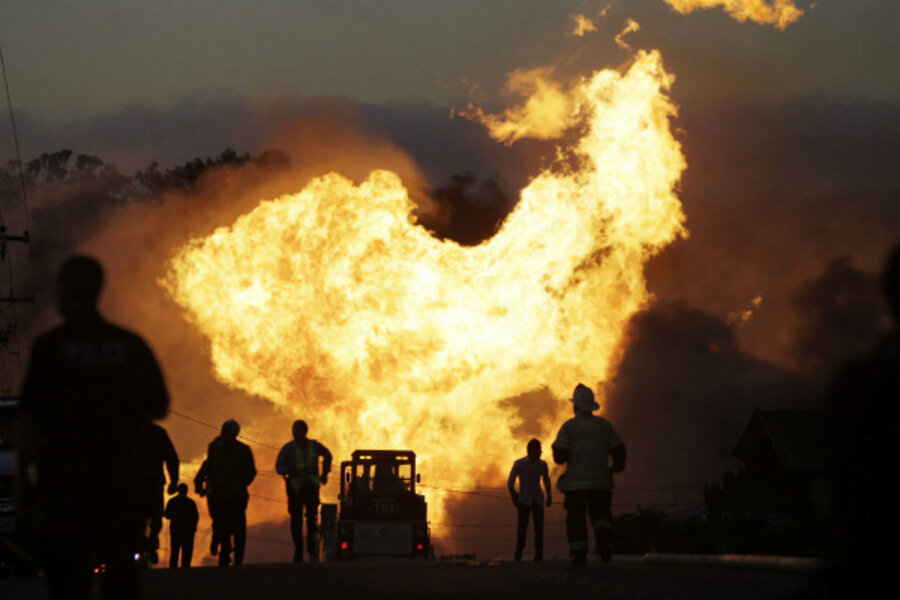San Bruno explosion case against PG&E could be hard to prove
Loading...
| LOS ANGELES
Pacific Gas & Electric Co. has been indicted by a federal grand jury, accused of violating the federal pipeline safety law between 2003 and 2010. Federal prosecutors say this resulted in a ruptured natural gas line and a massive explosion that killed eight people and leveled 38 homes in San Bruno, Calif., in 2010.
The maximum statutory penalty could be $6 million – based on $500,000 for each of 12 felony counts. The only other time federal prosecutors have accused a company of violating the federal Pipeline Safety Act was after a 1999 petroleum pipeline explosion that killed three in Bellingham, Wash.
Legal analysts say such suits are not only exceedingly rare, but that prosecutors will have an uphill battle proving their case. The indictment says PG&E “knowingly and willfully” failed to maintain important pipeline records and ignored aging sections of natural gas pipe in violation of federal regulations.
“It is extremely rare for federal prosecutors to charge a public utility for deaths in an accident," says Kevin Johnson, dean of the School of Law at the University of California, Davis. "The key will be the proverbial one of 'what PG&E knew and when,' especially with respect to violating the Pipeline Safety Act and the dangers flowing from any violation."
PG&E officials say they are committed to making the pipeline system safer and more reliable.
"San Bruno was a tragic accident. We've taken accountability and are deeply sorry," said PG&E Chairman and Chief Executive Tony Earley in a statement.
PG&E spokesman Greg Snapper said that the company plans to spend $2.7 billion for replacing pipeline, automating valves, strength testing pipe, and other upgrades.
Some analysts note that the total fine in this case is minuscule compared with the amount of money PG&E has already paid to fix and upgrade pipelines.
“If they win completely on every count – and frankly they had to be creative to find 12 – that would only be $6 million,” says Brigham McCown, former head of the Pipeline and Hazardous Materials Safety Administration, now a lawyer.
In the Olympic Pipeline criminal case in Washington State, fines totaled only $26 million – $11 million paid by the pipeline operator and another $15 million paid by Equilon Pipeline Co. LLC, which helped operate the pipeline. But later, a federal judge sentenced the former Olympic Pipeline Co. manager to six months in prison, along with a one-month prison term for control room manager Ronald Brentson.
But prison or jail terms seem unlikely in this case, some legal analysts say.
“It is certainly not unheard-of to find a corporation guilty of an offense and impose fines. It is much less common to impose fines or prison sentences on directors, officers, or employees of a corporation,” says Jesse Choper, a professor at the Boalt School of Law at the University of California, Berkeley. “The court or jury would have to find guilt beyond a reasonable doubt of a specific federal offense.
But the pipelines, constructed between 1944 and 1948, were cobbled together from several sections of leftover pipe segments well before any neighborhood was built over them, says Mr. McCown. “Knowingly and willfully is a very hard standard to meet,” he adds. “If it can’t be shown that PG&E even knew these were there, how can it be shown that they were willful about it?”
In the 1999 Washington case, it was shown that company personnel falsified records, which speaks to intent. “But say what you want about how the San Bruno explosion could or should have been prevented, it certainly wasn’t criminal,” he says.
Lawyers for the prosecution will contend that PG&E was well aware that 80 miles of pipeline had never been properly tested. The indictment charges that PG&E "failed to gather and integrate all relevant data for many of its older transmission lines."
But McCown and others say that the indictments aim to appease public opinion and may wind up keeping the focus off what needs to be done to prevent such mishaps in the future.
“It may be publicly popular to vilify a corporation, but ultimately I don’t think this is a good legal case to bring,” says McCown.
“What the CPUC [California Public Utilities Commission] is up against is trying to get utilities to perform a certain way and that requires cajoling, coaxing, and being supportive in addition to disciplining them,” he adds. “I think these actions mean well, but they don’t do anything to further the changes that we need to make in paying attention to infrastructure.”
Legal analysts say the trial can become a teachable moment.
“The public should watch for information that comes out about the safety risks about which PG&E officials were aware," says Professor Johnson of UC Davis. "The public should expect, at some point, PG&E to claim that the charges – and the defense – are likely to drive up energy rates for consumers.”
[Editor's Note: The original version of this article misstated the maximum statutory penalty that Pacific Gas & Electric Co. is facing. It is $6 million.]





